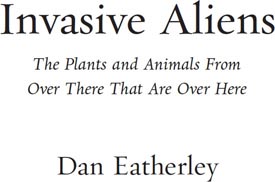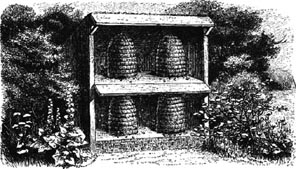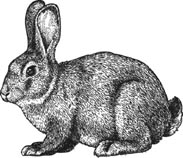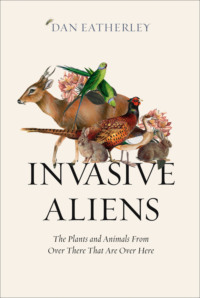
Полная версия
Invasive Aliens: Rabbits, rhododendrons, and the other animals and plants taking over the British Countryside



Copyright
William Collins
An imprint of HarperCollinsPublishers
1 London Bridge Street
London SE1 9GF
WilliamCollinsBooks.com
This eBook first published in Great Britain by William Collins in 2019
Copyright © Dan Eatherley 2019
Nineteenth-century engravings on chapter title pages are © Shutterstock, with the exception of chapter 6, which is © ilbusca / Getty Images
Cover design © Jo Walker
Cover images © Getty Images
Dan Eatherley asserts the moral right to be identified as the author of this work.
A catalogue record for this book is available from the British Library.
All rights reserved under International and Pan-American Copyright Conventions. By payment of the required fees, you have been granted the non-exclusive, non-transferable right to access and read the text of this e-book on-screen. No part of this text may be reproduced, transmitted, down-loaded, decompiled, reverse engineered, or stored in or introduced into any information storage and retrieval system, in any form or by any means, whether electronic or mechanical, now known or hereinafter invented, without the express written permission of HarperCollins.
Source ISBN: 9780008262747
eBook Edition © June 2019 ISBN: 9780008262761
Version: 2019-05-28
Dedication
To Georgia
Epigraph
‘Turkeys, carps, hops, pickerel, and beer,
Came into England all in one year.’
Chronicle of the Kings of England
unto the Death of King James, Sir Richard Baker, 1643
Contents
Cover
Title Page
Copyright
Dedication
Epigraph
Prologue
1 Ecological Explosions
2 First Invaders
3 Romans and Normans
4 New Worlds, New Invaders
5 The Empire Strikes Back
6 The Plant Hunters
7 Unwanted Hitch-Hikers
8 Fur Farm
9 Freshwater Invaders
10 Underneath the Waves
11 Fighting Fire with Fire
12 The Future
Further Reading
Index of Species
General Index
Acknowledgements
About the Book
About the Author
About the Publisher
Prologue
A Hornet’s Nest

Tetbury, Gloucestershire. 2.30 pm. Wednesday 28 September 2016
The wind had strengthened again and was blowing in short, powerful flurries. Graham paced up and down, his attention focused on the boundary hedges. Drawn by reports of sightings in the area, the team had last week netted several specimens of the invader that had been hawking for prey on ivy clinging to the trunk of one of the garden’s cypresses. A reliable line of sight had been achieved and further samples dispatched for DNA analysis. But that had been all.
Graham approached the conifer once more. No activity here today. As he turned back though, something danced in his peripheral vision, something way up in the cypress closest to the house. Was it his imagination? He squinted for a better look. Sure enough, four, five, maybe six, large-ish insects were whirling about the highest branches.
What the heck were they doing? What on earth was interesting them up there?
Not yet daring to hope, he reached for his binoculars. Within moments Graham confirmed the target species and shouted over to his colleague.
‘Hey Gordon! This could be it!’
Confidence building, Graham scanned the canopy for a few seconds, but saw only thick evergreen branches whipping and twisting in the wind. Frustrating. He stepped back a pace.
In that instant, a gust lifted the foliage enough to reveal a tell-tale patch of light brown against the darker trunk. Had he been standing a foot to the left or right, he would have seen nothing. It was just a glimpse, but now he was certain and made the call to the command centre: ‘I think we’ve found the nest.’ All Graham could do now was wait. And pray he was right.
The National Bee Unit – a division of APHA, the British government’s Animal and Plant Health Agency – has long expected this unwelcome visitor from the far side of the planet. Back home the Asian hornet is on the move, pushing from its native range, on the border of northern India and China, into Indonesia and South Korea. Soon Japan, too, will succumb. The species was confirmed in Europe as early as 2004 when a nest was discovered close to Agen in southwest France. No one really knows how it got there. The best guess is that a year or two earlier some fertile queens had been inadvertently shipped to Bordeaux in a container-load of ceramic pottery from eastern China.
The hornet found the temperate European conditions, similar to those back home, to its liking. Competition from local hornets was minimal – the Asian variety is smaller than its native counterpart, more like a very large wasp; and far quieter. (Experts say the chug-chug-chug of an approaching European hornet calls to mind a lumbering Chinook helicopter. If so, the newcomer is a Stealth fighter.) And it relished the plentiful supply of food in the shape of other aerial insects. This is where the problem lies, for while the Asian hornet is partial to hoverflies, wasps and various types of wild bee, it really goes to town on the honeybee, swooping in on hives to pluck off its far smaller quarry. With a (compound) eye on efficiency, worker hornets behead their prey then dismember it, biting off the wings, legs and abdomen, before taking back to the nest only the thorax, stuffed with protein-rich flight muscles – perfect fodder for the developing hornet brood. It’s the entomological equivalent of a shopping trip for prime rump steak, except the hornets do their own butchery.
In the worst cases, mobs of hornets will linger at the hive entrance, decapitating the emerging bees one after the other until they can move into the colony unchallenged, stripping it of honey, eggs and larvae. The bees back in Asia cobble together a defence of sorts, carpeting the hive entrance and swamping the intruders in a mass of shimmering abdomens. The heat-ball produced by the friction is enough to cook the intruder. The European bees have a go at this too but seem far less effective.
With the deck stacked in its favour, the Asian hornet has a field day. Over the summer, a single queen produces up to 6,000 young, almost ten times as many as typically found in a European hornet’s nest. Most offspring develop into sterile worker females – the ones wreaking the damage to bee colonies – but around 900 turn into breeding males and 350 become reproductive females, known as gynes, which form the next generation of queens. While many gynes either fail to mate or perish over the winter, a few survive to start new nests themselves the following year. It needs but a handful of these foundresses to succeed for a population to take off, particularly if the new nests aren’t detected and destroyed fast enough.
And that’s what happened in France. When nests were discovered in built-up areas, local firefighters were called in to remove them, but otherwise the authorities ignored the hornet, perhaps reassured by its lack of obvious threat towards humans. The insect isn’t especially aggressive and its sting no worse than that of the native hornet; in Europe perhaps a half-dozen fatalities to date can be attributed to Asian hornets – a statistic which compares favourably to deaths from wasp stings.
The honeybee population is less immune: in the Gironde département almost a third of colonies have been weakened or destroyed in a single year, one beekeeper losing 80 per cent of his hives. Dispersing at up to 80 kilometres each year – much further if the foundresses happen to hitch a ride in a passing vehicle – the Asian hornets have advanced unchecked over France. Along the way they have acquired a weakness for seafood, buzzing up and down coastal fish markets in search of small shrimps. It seems that any protein will do. By 2014, they had spread to Belgium, Portugal and Italy. One million of them were estimated to be in Germany. Then, in the early summer of 2016, they were spotted on the Channel Islands of Jersey and Alderney. It was only a matter of time before they reached the British mainland.
Changing agricultural practices going back a century have devastated Britain’s native bee and wasp populations, wiping out dozens of wild species and putting paid to many a honeybee colony. In recent decades, the threat to these important pollinators has worsened as crops have been drenched in pesticides and diseases have spread. Throw into the mix an exquisitely proficient bee-killer, and things have gone from bad to catastrophic.
For this reason, the UK government has adopted a zero-tolerance approach. The overriding objective of the Asian hornet response plan, the first of its kind in Europe, is the rapid interception and destruction of the insects before they get established. Beekeepers throughout the land are now on high alert, a select few tasked with active surveillance for the hornet, their colonies designated ‘sentinel’ apiaries. Meanwhile, members of the public are being encouraged to report, including via a mobile phone app, potential sightings of the visually distinctive invader. Unlike the native hornet, which sports a lively pattern of yellows and chestnuts on a dark-brown background, the Asian species is mostly black, save for a band of gold across the fourth segment of its abdomen. Added to that, it looks as if it’s waded knee-high through a puddle of yellow paint. Until now, none of the thousand-plus sightings, routed to the National Bee Unit (located at Sand Hutton, just outside York) for confirmation, have proved positive. But vigilance is key and government-funded bee inspectors are on the front line. A contingency plan – regularly field-tested – is in place. But before it can be executed, a positive identification is needed. In other words, someone has to catch a specimen.
Tuesday 20 September 2016
‘KILLER ASIAN HORNET INVASION’
‘SWARMS OF VICIOUS HORNETS SET TO HEAD TO BRITAIN’
‘MILITARY-STYLE OPERATION SPARKED TO DESTROY NESTS’
‘BRITONS WARNED OF DEADLY ASIAN HORNETS THAT CAN KILL FIFTY BEES A DAY’
The newspaper headlines that morning were typically understated. But they raised public awareness, and that was the point. In a press release issued the night before, the government confirmed that an Asian hornet had been identified in the Gloucestershire market town of Tetbury, and detailed the urgent steps that would form its rapid response to the invader. These included setting up a three-mile surveillance zone around the town, establishing a command centre at an undisclosed location and deploying bee inspectors to find the Asian hornet nest and pest control teams to destroy it. Emphasising the minimal threat to public safety posed by the hornets, Nicola Spence – the government’s top official for bee and plant health – nevertheless promised ‘swift and robust action’.
Monday 26 September 2016
The initial days of the operation proved frustrating. Each morning the inspectors were briefed before heading off in pairs to local apiaries armed with compasses, mobile phones to record grid references, binoculars and purpose-built hornet traps. At each site, the bee suit-clad inspectors hung around for a couple of hours hoping to spot hornets. The team worked off a list – provided by the Gloucestershire Beekeepers Association – which included apiaries at Prince Charles’s Highgrove estate and the Westonbirt arboretum. Some sites were located up to 20 kilometres from Tetbury, the initial surveillance zone having been extended. Perhaps the first sighting had been just the tip of the iceberg. Perhaps multiple nests were out there. But it soon became apparent that the team was wasting time at distant apiaries – the real action was happening less than a kilometre from the original discovery. And not at beehives.
‘I’m outside the Tesco’s,’ said one caller. ‘I’ve just seen some of those wasp-things.’ Sure enough, Asian hornets were confirmed buzzing about the red foliage of berberis hedging in the supermarket car park. More were clocked taking aphids from a willow coppice in a private garden nearby. And then this morning St Mary’s Primary School, in the centre of Tetbury, reported them on ivy in the playground, the area in question rapidly cordoned off as the inspectors went to work.
In predation mode, the hornets seemed oblivious to the fuss. They were not afraid of humans. They just carried on hawking. Inspectors could walk right up to them and stick them in a net. Keeping an eye on the insects as they flew off was trickier. At first, in the hope of improving the hornets’ visibility, the inspectors netted the insects, taped feathers to their abdomens and released them. But the hornets didn’t cooperate; instead they stopped at nearby trees to remove the cumbersome tags and zoomed off. The inspectors got their eye in eventually and abandoned the approach. It was not worth the hassle, you could see a hornet flying without a feather and get a good feel for the direction. After much perseverance, lines of sight were collected. The team was closing in.
One o’clock. Wednesday 28 September 2016
Graham Royle, a Cheshire-based seasonal bee inspector, had arrived in Tetbury the night before. He was among those providing relief to the 20-strong task force. More than 100 sites had been visited over the previous week, 50 traps deployed and dozens of fresh hornet sightings authenticated. A total of 94 separate observations would eventually be documented. Graham himself recorded a decent line of sight from a hedge that very morning, having trapped and released a hornet close to some ivy. Just before lunchtime, word came through from the command centre: ‘We’ve got an intersect.’
As it turned out, the flight lines – four or five good ones – which were plotted on a map didn’t converge neatly at one spot, but the criss-crossing did hint at a patch on the outskirts of Tetbury. Sixteen inspectors congregated in a car park. Teams of two, each provided with a map, started walking a section of this patch. It was not long afterwards that Graham, and fellow inspector Gordon Bull, found the nest. The garden with the cypress trees was a mere 600 metres from where the first hornet was spotted 23 days before.
Photos of the hornet’s nest were emailed for confirmation to Dr Quentin Rome at the Muséum National d’Histoire Naturelle in Paris – he has studied the Asian hornet’s advance with grim fascination for more than a decade. The nest was treated with a pesticide called Ficam B, an odourless white dust which is relatively harmless to humans but lethal to insects. Within an hour the nest was a mass grave.
The pumpkin-sized ball of chewed wood fibre was shipped to Sand Hutton for full analysis. The entire European population of Asian hornets belongs to just one of 13 subtypes known from the native range, implying a single introduction event, and genetic analysis later confirmed that the Tetbury hornets were of this same subtype. This suggested that they had indeed crossed the English Channel, rather than arriving independently from Asia. Further nests remained a possibility. Residents were asked to remain vigilant and bee inspectors would stay on for a further two weeks until the Tetbury outbreak was declared over.
Woolacombe, North Devon. One year later
As he did every day at this time of the year, retired physics teacher Martyn Hocking headed up the valley to visit his bees. At his back the mid-afternoon sun was still high over the sea. It was best to visit the apiary while the occupants were out and about: there would be fewer to deal with. He heard the hum before he saw the hives; right now, they were drowning in late summer bracken and barely visible.
Giving the first hive a generous blast from his smoker, he lifted the lid and administered a dose of sugar syrup. A large dark insect flitted past. Too big for a honeybee drone. The thing hovered for a moment, offering an unmistakable view of a yellow-orange band on an otherwise black abdomen. One of Martyn’s bees writhed in the grip of the larger insect, which seconds later darted off, vanishing into the emerald background as quickly as it had arrived.
1
Ecological Explosions

‘Let it be remembered how powerful the influence of a single introduced tree or mammal has been shown to be.’
On the Origin of Species, Charles Darwin, 1859
The 16 July 1898 edition of the Daily Mail devotes a single paragraph to the revelation that unusual creatures were on the loose in one of London’s better-heeled districts and defying all attempts at capture. According to the paper, ‘The wild animals on Hampstead Heath have just received an unexpected addition in the shape of two monkeys which have escaped from custody and are now enjoying a free and open life on the salubrious heights.’ A reward offered for the safe return of the simians – escaped pets from the nearby Bull and Bush tavern – proved unnecessary: a couple of days later the fugitives slunk back to the drinking house. Liberty hadn’t agreed with them. ‘They were in a deplorably dirty and woe-begone condition,’ as one account had it.
It turns out that Hampstead Heath, a windswept expanse on a sandy ridge to the north of the city, is no stranger to the exotic. In 1944, monkey business was again reported from the Heath, the arboreal frolics of a pair dubbed Jack and Jill causing disturbance on this occasion. Things didn’t end much better that time: Jill was shot and her dejected playmate handed himself in to the authorities. Then there was the young seal fished from a pond in 1926 having alarmed nocturnal anglers by ‘barking like a dog with a sore throat’. Other tales tell of a phantom gorilla, of giant spiders, of marauding bands of wild pigs.
For the people of London, the Heath is a little piece of countryside on their doorstep, an oasis in which to de-stress and reconnect with nature. Keats, Shelley, Wordsworth and Constable were among the many poets and artists in thrall to its bucolic charms, its wild and unspoilt landscapes. So precious is this place that the threat of quarrying and house-building prompted an 1871 Act of Parliament protecting for ever ‘the natural aspect and state of the Heath’.
But taking a stroll on the eastern end of the Heath one chilly autumnal morning in 2017, I was struck by just how much around me wasn’t ‘natural’ in the sense of representing native British fauna and flora. The most obvious example was the resident flock of a hundred or so ring-necked parakeets with their frequent shrill calls. With eyes closed, I could have been roaming a Darjeeling tea estate. The birds originate from sub-Saharan Africa and South Asia and the stories to explain their introduction are every bit as colourful as their plumage. The most enduring legend is that they flew off the set of The African Queen during filming of the 1951 movie at Isleworth studios. Others point the finger at Jimi Hendrix for releasing a pair on Carnaby Street at the height of the Swinging Sixties. More probable is that London’s parakeet population – the current estimate is 30,000 and growing – established itself after successive escapes from pet shops and aviaries. Perhaps not as numerous as in other parts of the capital, where parakeets are accused of beating woodpeckers and nuthatches to the choicest nesting sites, the Heath’s contingent has been around for decades and seems to coexist happily with the locals. Then there were the grey squirrels. Victorians were the first to take a shine to the bushy-tailed rodents from North America and did their darnedest to spread them around the countryside. Woodland managers and red squirrel lovers alike have been gnashing their teeth ever since.
There’s not much natural about the landscape either. Like every other part of Britain, Hampstead Heath has been managed and manipulated by people for centuries if not millennia. Cattle, sheep and goats – all first domesticated in the Middle East – have been raised here since the Neolithic period, suppressing forest regrowth and creating pasture. These days grazing duties fall to rabbits introduced from the Iberian Peninsula by the Normans. Or was it the Romans? Rabbits would give squirrels a run for their money for the title of ‘world’s worst pest’ – just ask an Aussie farmer – but on the Heath they get a pass because their incessant munching helps preserve the acid grassland, and in turn a community of rare heathland organisms. From the eighteenth century, what little was left of the Heath’s primeval woodland of pedunculate and sessile oaks, beech and birch – long exploited for timber and fuel – began to be ‘enhanced’ with Turkey oaks, horse-chestnuts, black locusts, rhododendrons, laurels and dozens more species from around the world. Early plantings were at the behest of aristocrats like Sir Thomas Maryon Wilson, Lord of Hampstead Manor, and the Mansfields of Kenwood House, whose estates constituted or bordered the Heath, but the ‘parkifying’, which included planting still more exotic trees and shrubs, continued long after the 1871 Act.
Meanwhile, the Heath’s mineral-rich springs, dribbling out where porous Bagshot Sands meet impermeable London Clay, were exploited for drinking, laundry and their therapeutic properties. In time, the water, which had once collected in mosquito-infested swamps and bogs, was corralled into a series of ponds, which would later become a playground for bathers and anglers. Here, too, the roll-call of introductions is impressive from mandarin ducks and Canada geese to alpine newts and marsh frogs, from carp and catfish to red-eared terrapins. Some got here under their own steam. Most received a helping hand.
Human agency is suspected in particular for the arrival of two types of crayfish, among the Heath’s more infamous aquatic denizens. The Turkish, or narrow-clawed, crayfish reached Britain in the 1930s, being joined in the 1990s by the red swamp crayfish from North America. Culinary motives are thought to have driven both introductions, with persons unknown considering Hampstead Heath the ideal place to rear them. They were spot on, for the two crayfish varieties multiplied, and are today well-entrenched in the ponds. This became painfully evident in 2012 when swimmers in the men’s pond complained of being nipped on the toes and, according to one report, ‘in altogether more sensitive places’. It gives ‘bottom-feeder’ a whole new meaning. Not long ago, the City of London Corporation, who manage the Heath, removed 500 red swamp crayfish from a single pond during routine maintenance over the course of just three days. With a single female producing up to 600 viable young in one go, total eradication is a tall order.


